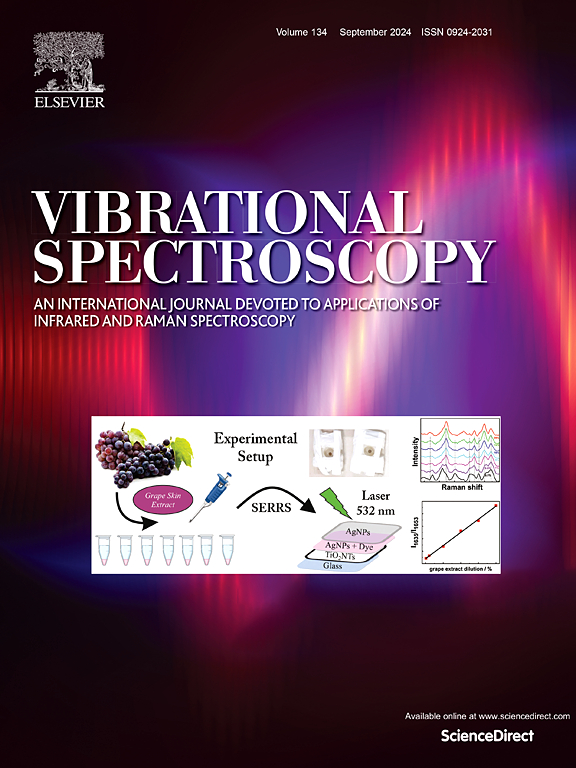用ATR-FTIR光谱和化学计量学预测乳腺癌前哨淋巴结转移的可能性
IF 3.1
3区 化学
Q2 CHEMISTRY, ANALYTICAL
引用次数: 0
摘要
腋窝淋巴结的状态被认为是浸润性乳腺癌(BC)患者最重要的预后指标之一。纪念斯隆-凯特琳癌症中心(MSKCC)乳腺服务部(Breast Service of Memorial Sloan Kettering Cancer Center,简称MSKCC)的nomogram放射图是为了获得转移到前哨淋巴结(sentinel lymph node,简称SLN)的可能性。收集28例BC I、II、III期患者血浆,采用衰减全反射-傅里叶变换红外光谱(ATR-FTIR)进行分析。因此,本研究的目的是利用血浆中的ATR-FTIR光谱和化学计量学来预测乳腺癌中SLN转移的概率≥ 50 %(模型1)或>; 30 %(模型2)由MSKCC nomogram确定。采用正交偏最小二乘判别分析(OPLS-DA)建立化学计量模型。模型1和模型2的敏感性和特异性均为100 %。模型1采用7个潜在变量(LV),累积方差为92.56 %,交叉验证均方根误差(RMSECV)为0.0096。模型2对6 LV的累积方差为94.17 %,RMSECV为0.0031。仅对模型1进行外部验证,获得100 %的准确率,验证的RMSE (RMSEV)为0.274。蛋白质和核酸是对这一预测贡献最大的生物分子。因此,ATR-FTIR光谱对肿瘤的侵袭性和转移到SLN的可能性产生了有价值的见解。本文章由计算机程序翻译,如有差异,请以英文原文为准。
Prediction of the probability of metastasis to the sentinel lymph node in breast cancer by ATR-FTIR spectroscopy and chemometrics
The status of axillary lymph nodes is considered one of the most critical prognostic indicators for patients diagnosed with invasive breast cancer (BC). The Breast Service of Memorial Sloan Kettering Cancer Center (MSKCC) nomogram was developed to obtain the likelihood of metastasis to the sentinel lymph node (SLN). Blood plasma from 28 patients with BC stages I, II, and III were collected and analyzed by Attenuated total reflectance-Fourier transform infrared spectroscopy (ATR-FTIR). Therefore, the aim of the study is to use ATR-FTIR spectroscopy and chemometrics in blood plasma to predict the probability of SLN metastases in breast cancer in ≥ 50 % (Model 1) or > 30 % (Model 2) determined by the MSKCC nomogram. The chemometric models were performed with orthogonal partial least squares discriminant analysis (OPLS-DA). Both Models 1 and 2 obtained sensitivity and specificity of 100 %. Model 1 was built with 7 latent variables (LV) having a cumulative variance of 92.56 % and root mean square error of cross-validation (RMSECV) of 0.0096. Model 2 for 6 LV had a cumulative variance of 94.17 % and RMSECV of 0.0031. External validation was only tested for Model 1, obtaining 100 % accuracy and RMSE of validation (RMSEV) of 0.274. Proteins and nucleic acids were the biomolecules with the highest contribution to this prediction. Therefore, ATR-FTIR spectroscopy generates valuable insights into the tumor aggressiveness and the probability of metastasis to the SLN.
求助全文
通过发布文献求助,成功后即可免费获取论文全文。
去求助
来源期刊

Vibrational Spectroscopy
化学-分析化学
CiteScore
4.70
自引率
4.00%
发文量
103
审稿时长
52 days
期刊介绍:
Vibrational Spectroscopy provides a vehicle for the publication of original research that focuses on vibrational spectroscopy. This covers infrared, near-infrared and Raman spectroscopies and publishes papers dealing with developments in applications, theory, techniques and instrumentation.
The topics covered by the journal include:
Sampling techniques,
Vibrational spectroscopy coupled with separation techniques,
Instrumentation (Fourier transform, conventional and laser based),
Data manipulation,
Spectra-structure correlation and group frequencies.
The application areas covered include:
Analytical chemistry,
Bio-organic and bio-inorganic chemistry,
Organic chemistry,
Inorganic chemistry,
Catalysis,
Environmental science,
Industrial chemistry,
Materials science,
Physical chemistry,
Polymer science,
Process control,
Specialized problem solving.
 求助内容:
求助内容: 应助结果提醒方式:
应助结果提醒方式:


